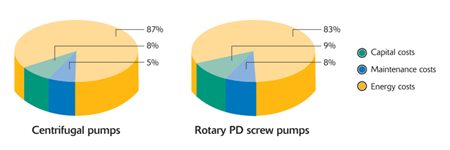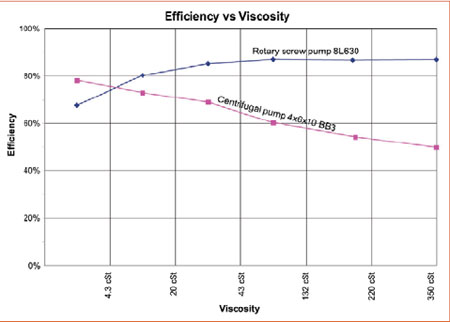Transporting crude oil has always presented unique fluid-handling challenges. For example, pipelines often traverse remote territory in harsh environments, so they require pumping solutions capable of performing reliably over many years with minimal maintenance. Temperature and crude oil grade variations, as well as contaminants like sand or water, can increase the range of viscosities a pipeline must be able to accommodate. Additionally, the demand for increased energy efficiency and greater environmental responsibility affects all industries, particularly oil and gas.
For years, rotary pumps have been used to deliver high-efficiency, low-maintenance fluid-handling solutions for critical applications. However, screw pumps are often considered expensive, which prevents many crude oil transport companies from taking advantage of the benefits of energy savings and reduced environmental impact.
Positive displacement screw pumps can deliver cost advantages. Consider a typical 250,000-barrel-per-day (bpd) crude oil pumping station in Canada using three rotary positive displacement screw pumps operating in parallel with one standby pump. Compare their cost performance to the traditional centrifugal pump solution of two pumps operating in parallel with one standby pump.
During a five-year period of using the PD alternative, combined capital and maintenance costs will account for less than 17 percent of the Total Cost of Ownership (TCO), and efficiency is 27 percent higher than the centrifugal solution. The PD alternative reduces energy costs by 29 percent.
Centrifugal and Rotary PD Screw Pump Costs during Five Year Period
Based on a 250,000 bpd crude oil pumping station in Canada handling a product viscosity of 350 cSt

Capital, Maintenance and Energy Costs for Centrifugal and Rotary Positive Displacement Screw Pumps
Based on a 250,000 bpd crude oil pumping station operating for five years in Canada

Despite cost advantages, rotary PD screw pumps are still often misunderstood. While a variety of designs and operating ranges are available, they all work on the same basic principle: a rotating cavity or chamber within a close-fitting housing is filled with process fluid, the cavity or chamber closes due to the rotary action of the pump shaft(s) and the fluid is transported to the discharge and displaced, which is accomplished without the need for inlet or outlet check valves.
In addition, the delivered capacity is nearly constant throughout the discharge pressure range due to the close internal pump clearances. This stable hydraulic-performance characteristic allows for a high degree of system control if the shape of the system head curve should vary. By contrast, a centrifugal pump is at the mercy of the system head curve unless its duty point is externally manipulated.
The hydraulic principle behind screw pump operation delivers high volumetric and high overall operating efficiencies in addition to long mean time between repairs and ease-of-maintenance features for field servicing, which combine to maximize operational uptime. Other advantages include:
- Constant flow, even in the presence of varying system back pressures due to viscosity changes
- Nonpulsating flow, without the need for pulsation dampeners, which eliminates stresses imposed on the pipeline system and reduces the risk of pipeline failures
- Low noise and vibration levels, minimizing foundation requirements
Positive displacement screw pumps also create flow, whereas centrifugal pumps create pressure. Oil pipelines normally require constant flow at various pressures, and the required boost pressure will vary with changes in viscosity. In the event of an unplanned shutdown, the product in the pipeline can cool and allow the crude viscosity to increase to a point at which a centrifugal pump might not be able to produce sufficient discharge pressure to initiate, and ultimately clear, the pipeline.
Comparing Rotary PD Screw Pumps and Centrifugal Pumps
It is not always obvious whether to use a rotary PD screw pump or a centrifugal pump, but examining the application's needs and the differences between the two technologies is a good place to start. When it comes to flow rate versus pressure, the centrifugal pump's capacity will increase as the total developed head decreases; the positive displacement pump usually delivers a constant flow in spite of differential pressure changes. In terms of viscosity, a centrifugal pump's flow is reduced as viscosity increases, while the positive displacement pump's flow increases.
Efficiency of Rotary Positive Displacement Screw Pumps
Used for High-Viscosity Crude Oil

When mechanical efficiency is applied to viscosity, the results are equally clear. Due to the de-rating effect on the capacity, total developed head and efficiency, the overall efficiency of a centrifugal pump declines as viscosity increases. The overall efficiency of a rotary PD screw pump typically improves when handling more viscous fluids due to the increased volumetric efficiency, a key variable when calculating a piece of rotating equipment's efficiency.
Centrifugal pumps are designed to operate at their Best Efficiency Point (BEP). Moving too far from this fundamental design point runs the risk of reducing pump life. Positive displacement screw pumps are volumetric machines whose performance is not governed by the BEP requirement of kinetic pumps.
Examples
Some organizations worldwide are already successfully using rotary PD screw pumps for transporting crude oil. A French oil company building a pipeline in Africa to transport viscous crude oil 90 miles from the production field to a refinery had originally considered installing piston pumps. After estimating the total cost of equipment purchase, maintenance and energy use over time, the company determined it would be 50 percent less expensive to buy six rotary positive displacement screw pumps.
Another company, retrofitting an existing 375-mile pipeline to transport 60,000 bpd of viscous crude oil in the western United States, came to a similar conclusion. It bought 20 three-screw rotary PD pumps and projects saving up to $17.3 million in operating costs over five years compared to other pumping options.
In conclusion, rotary PD screw pumps can transport a wide range of fluids, including high-viscosity crude oil. They deliver reliability and performance, so companies can count on longer periods between repairs. When they need service, their straightforward design minimizes downtime.
Perhaps the most important point for rotary positive displacement screw pumps in today's global economic climate is cost-saving advantages. Their success rate lets crude oil transport organizations combat the industry's higher energy costs.
Pumps and Systems, April 2010

 Mike Moore is the director of global oil & gas marketing for Colfax Corporation, reporting to the operation in Monroe, N.C. Moore can be reached at 519-209-1699.
Mike Moore is the director of global oil & gas marketing for Colfax Corporation, reporting to the operation in Monroe, N.C. Moore can be reached at 519-209-1699.